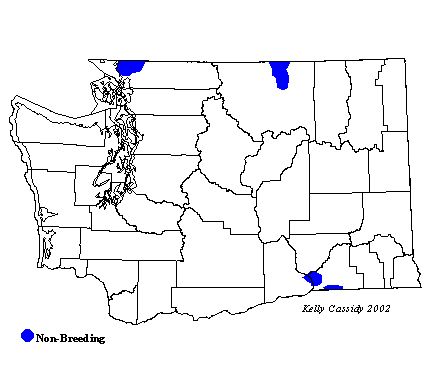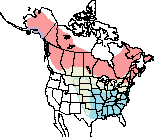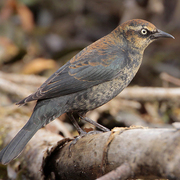Rusty Blackbird
General Description
Rusty Blackbirds are rare winter visitors to Washington. We are most likely to see these birds in non-breeding season, in the plumage that gives them their name. Non-breeding males are black with rusty edges on their feathers. Females are lighter brown all over, with buff-colored mottling and gray rumps. Rusty Blackbirds are fairly slender birds with long wings and tails. Both sexes have yellow eyes in all plumages. During breeding season, males are black with slightly iridescent purple-green plumage, and females are dull brown. Male Brewer's Blackbirds look similar, but lack the rusty edging on their feathers, are glossier during the breeding season, and have longer tails.
Habitat
Rusty Blackbirds nest in spruce bogs and other wet, forested areas throughout Canada and Alaska. They often nest in small clear-cuts or openings caused by natural disturbances. During migration and winter, they inhabit wooded swamps, but forage in open areas and cattle feedlots. They typically prefer wooded areas more than do other blackbird species.
Behavior
In Washington, Rusty Blackbirds may be mixed in with flocks of Brewer's or Red-winged Blackbirds. They walk along the ground while foraging, often turning leaves over to expose food, and will feed at pond or wetland edges, sticking their heads underwater to take food from the bottom.
Diet
Rusty Blackbirds eat many aquatic insects and other small invertebrates. They also eat seeds and waste grain, especially during winter.
Nesting
Sometimes Rusty Blackbirds breed in small, loose colonies, but isolated, monogamous pairs are the norm. Nests are usually close to or directly above the water, in dense trees or shrubs. The female builds a bulky open cup with a lichen foundation, a body of grass, twigs, and decaying plant material, and a fine grass lining. She incubates 3 to 5 eggs for about two weeks and then broods the young after they hatch. Both sexes feed the young, which leave the nest about 11 days after hatching. They cannot fly when they leave the nest, but learn within a few days.
Migration Status
Rusty Blackbirds travel between their northern breeding grounds and southern US wintering grounds during the late fall and early spring.
Conservation Status
Rusty Blackbirds are the least well known of the North American blackbirds. While most of their breeding range is remote from human disturbance, their wintering grounds are more vulnerable, and more study is needed to ascertain their status.
When and Where to Find in Washington
Rusty Blackbirds are rare but regular fall and winter visitors throughout lowland Washington. Birds have been seen in Whatcom, Snohomish, Clark, Thurston, King, and Okanogan Counties, and are found annually in the Walla Walla area. They breed as far south as southern British Columbia, but are more common breeders in the central interior part of that province.
 Abundance
Abundance
| Ecoregion | Jan | Feb | Mar | Apr | May | Jun | Jul | Aug | Sep | Oct | Nov | Dec |
|---|---|---|---|---|---|---|---|---|---|---|---|---|
| Oceanic | ||||||||||||
| Pacific Northwest Coast | ||||||||||||
| Puget Trough | R | R | R | R | R | |||||||
| North Cascades | ||||||||||||
| West Cascades | ||||||||||||
| East Cascades | ||||||||||||
| Okanogan | ||||||||||||
| Canadian Rockies | ||||||||||||
| Blue Mountains | ||||||||||||
| Columbia Plateau |
Washington Range Map

North American Range Map


Family Members
 BobolinkDolichonyx oryzivorus
BobolinkDolichonyx oryzivorus Red-winged BlackbirdAgelaius phoeniceus
Red-winged BlackbirdAgelaius phoeniceus Tricolored BlackbirdAgelaius tricolor
Tricolored BlackbirdAgelaius tricolor Western MeadowlarkSturnella neglecta
Western MeadowlarkSturnella neglecta Yellow-headed BlackbirdXanthocephalus xanthocephalus
Yellow-headed BlackbirdXanthocephalus xanthocephalus Rusty BlackbirdEuphagus carolinus
Rusty BlackbirdEuphagus carolinus Brewer's BlackbirdEuphagus cyanocephalus
Brewer's BlackbirdEuphagus cyanocephalus Common GrackleQuiscalus quiscula
Common GrackleQuiscalus quiscula Great-tailed GrackleQuiscalus mexicanus
Great-tailed GrackleQuiscalus mexicanus Brown-headed CowbirdMolothrus ater
Brown-headed CowbirdMolothrus ater Orchard OrioleIcterus spurius
Orchard OrioleIcterus spurius Hooded OrioleIcterus cucullatus
Hooded OrioleIcterus cucullatus Bullock's OrioleIcterus bullockii
Bullock's OrioleIcterus bullockii Baltimore OrioleIcterus galbula
Baltimore OrioleIcterus galbula Scott's OrioleIcterus parisorum
Scott's OrioleIcterus parisorum

